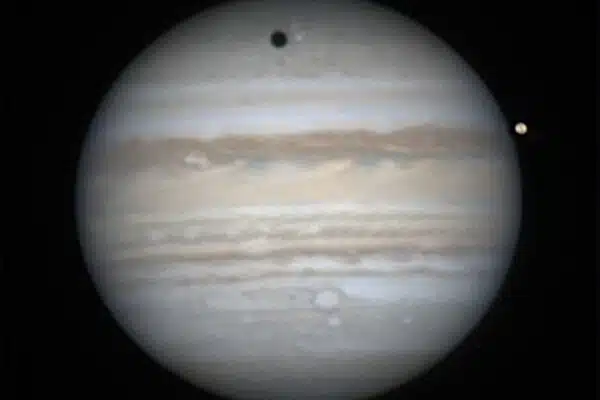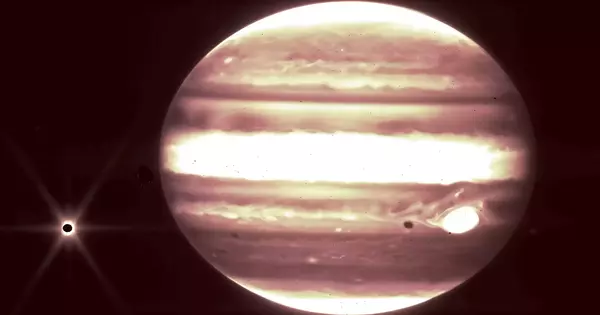The James Webb Space Telescope of NASA has detected a previously unseen structure in Jupiter’s atmosphere. The high-speed jet stream, which is more than 3,000 miles (4,800 kilometers) broad, rests above the main cloud decks on Jupiter’s equator. The discovery of this jet sheds light on how the layers of Jupiter’s famously tumultuous atmosphere interact with one another, as well as how Webb is particularly capable of following those features.
“This completely surprised us,” said Ricardo Hueso, main author of the study presenting the findings at the University of the Basque Country in Bilbao, Spain. “What we have always seen as blurred hazes in Jupiter’s atmosphere now appear as crisp features that we can track along with the planet’s fast rotation.”
Webb’s NIRCam (Near-Infrared Camera) data from July 2022 was analyzed by the research team. The Early Release Science program, led by Imke de Pater of the University of California, Berkeley, and Thierry Fouchet of the Observatory of Paris, was designed to take images of Jupiter 10 hours apart, or once a Jupiter day, in four different filters, each uniquely capable of detecting changes in small features at different altitudes of Jupiter’s atmosphere.
This completely surprised us. What we have always seen as blurred hazes in Jupiter’s atmosphere now appear as crisp features that we can track along with the planet’s fast rotation.
Ricardo Hueso
“Even though various ground-based telescopes, spacecraft like NASA’s Juno and Cassini, and NASA’s Hubble Space Telescope have observed the Jovian system’s changing weather patterns, Webb has already provided new findings on Jupiter’s rings, satellites, and its atmosphere,” he said.
While Jupiter and Earth are very different in many aspects – Jupiter is a gas giant, while Earth is a rocky, temperate world – both planets have layered atmospheres. These other missions’ observations of infrared, visible, radio, and ultraviolet light wavelengths identify the lower, deeper layers of the planet’s atmosphere, where massive storms and ammonia ice clouds reside.
Webb’s new peek into the near-infrared is more sensitive to the higher-altitude layers of the atmosphere, some 15-30 miles (25-50 kilometers) above Jupiter’s cloud tops. High-altitude hazes appear fuzzy in near-infrared imaging, with increased brightness over the equatorial area. Finer details are resolved within the bright hazy band with Webb.

The newly discovered jet stream travels at around 320 miles per hour (515 kilometers per hour), which is twice the sustained wind speed of a Category 5 storm on Earth. It is located in Jupiter’s lower stratosphere, around 25 miles (40 kilometers) above the clouds.
The team was able to measure how fast the winds vary with altitude and generate wind shears by comparing the winds detected by Webb at high altitudes to the winds observed by Hubble at deeper layers.
While Webb’s excellent resolution and wavelength coverage enabled the detection of small cloud features used to track the jet, complementary Hubble observations taken one day after the Webb observations were also critical in determining the base state of Jupiter’s equatorial atmosphere and observing the development of convective storms in Jupiter’s equator that were not connected to the jet.
“We knew that the different wavelengths of Webb and Hubble would reveal the three-dimensional structure of storm clouds, but we were also able to use the timing of the data to see how rapidly storms develop,” said team member Michael Wong of the University of California, Berkeley, who led the associated Hubble observations.
The researchers are looking forward to additional observations of Jupiter with Webb to determine if the jet’s speed and altitude change over time.
“Jupiter has a complicated but repeatable pattern of winds and temperatures in its equatorial stratosphere, high above the winds measured in clouds and hazes at these wavelengths,” team member Leigh Fletcher of the University of Leicester in the United Kingdom noted. “If the strength of this new jet is connected to this oscillating stratospheric pattern, we might expect the jet to vary considerably over the next 2 to 4 years — it’ll be really exciting to test this theory in the years to come.”
“It’s amazing to me that, after years of tracking Jupiter’s clouds and winds from numerous observatories, we still have more to learn about Jupiter, and features like this jet can remain hidden from view until these new NIRCam images were taken in 2022,” continued Fletcher.
















